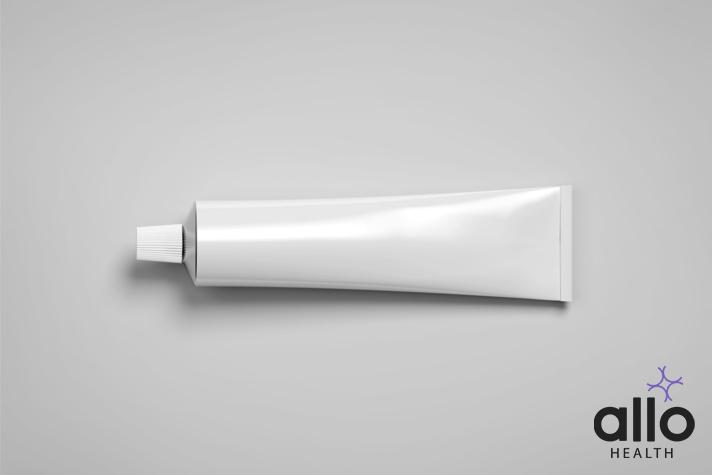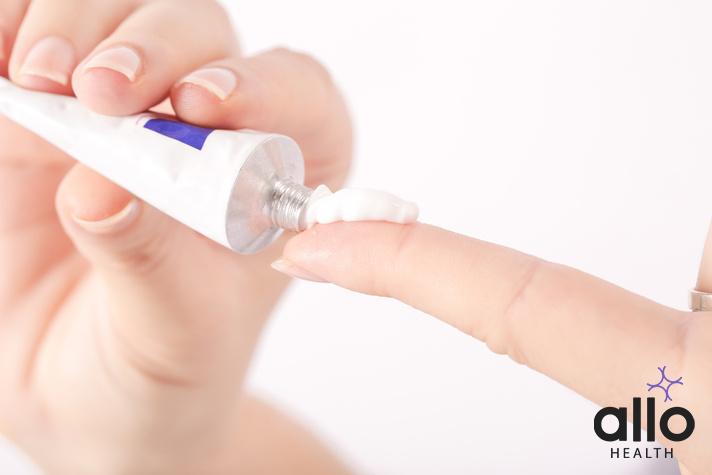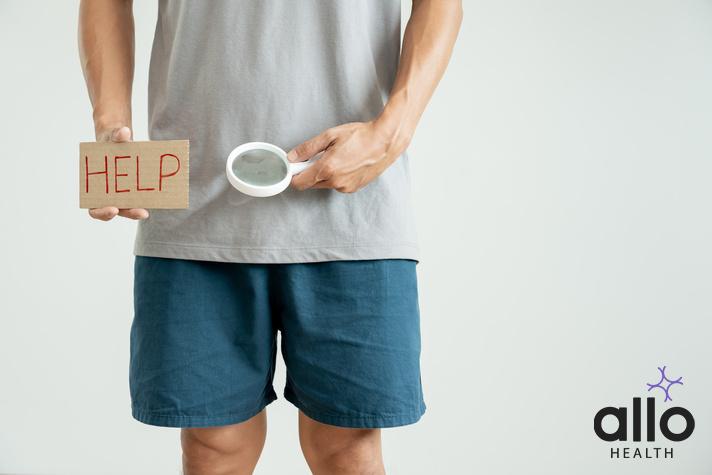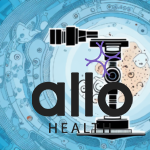Benefits and Risks of Testosterone Cream

Allo Health is dedicated to personalized well-being, offering support and trusted information tailored to individual health goals. The platform emphasizes human-generated content, led by a distinguished medical team of experts, including physicians and sexual health specialists. Their commitment to credibility involves rigorous fact-checking, authoritative research, and continuous updates to ensure accurate, up-to-date information. Allo Health's unique approach goes beyond conventional platforms, providing expert-led insights and a continuous commitment to excellence, with user feedback playing a crucial role in shaping the platform's authoritative voice.

Dr Sanina Mansoor holds MBBS degree from Yenepoya university,Mangalore.She has 8 years of experience working as a medical officer at various health centres and medical colleges.
Why This Was Upated?
Our experts continually monitor the health and wellness space, and we update our articles when new information became available.
Updated on 16 April, 2024
- Article was updated as part of our commitment to diversity, equity, and inclusion.

"The following blog article may discuss medical treatments and interventions. However, it is important to note that the information provided is for general educational purposes only and should not be considered as a substitute for professional medical advice, diagnosis, or treatment. Always seek the guidance of a qualified healthcare professional for personalized medical advice.
Book consultation
Medical treatments are complex and should be tailored to individual circumstances. The information presented in this blog may not be applicable to everyone, as each person's medical condition, history, and needs are unique. Only a qualified healthcare professional can evaluate your specific medical situation, consider relevant factors, and provide appropriate recommendations for diagnosis, treatment options, and monitoring.
It is crucial to note that self-diagnosis, self-medication, or relying solely on the information provided in this blog for treatment decisions can have serious health consequences. "
Testosterone cream is a topical form of testosterone replacement therapy (TRT). It’s used to treat low testosterone levels in men and, sometimes, women. This article explains testosterone cream, its uses, benefits, risks, and how it compares to other forms of TRT.
What is Testosterone Creams?
Testosterone cream is a type of hormone replacement therapy that delivers testosterone, a key male hormone, through the skin. It’s used primarily to treat men with low testosterone levels, a condition known as hypogonadism. The cream is applied directly to the skin, allowing the hormone to be absorbed into the bloodstream.
Key Aspects of Testosterone Cream:
- Form of Administration: It’s a topical application, which means it’s applied to the skin.
- Purpose: Primarily to increase testosterone levels in individuals who have low levels of this hormone.
- Usage: Commonly used by men, but sometimes prescribed for women as well.
- Absorption: Testosterone is absorbed through the skin into the bloodstream.
- Convenience: Offers an alternative to other forms of testosterone replacement therapy like injections or gels, which some may find more convenient and less invasive.
It’s important to use testosterone cream as directed by a healthcare provider, who will determine the appropriate dosage and monitor its effects, including any potential side effects or interactions with other medications.
Benefits of Testosterone Cream
The benefits of testosterone cream, which is a form of testosterone replacement therapy, are significant, especially for those with low testosterone levels.
- Boosts Sex Drive: Testosterone is integral in maintaining a healthy libido. Using testosterone cream can help restore sex drive, especially in individuals who have experienced a decrease due to low testosterone levels.
- Supports Muscle Mass and Weight Control: Testosterone plays a crucial role in muscle growth and fat distribution. Applying testosterone cream can aid in gaining muscle mass and managing weight, potentially reducing the risk of weight gain.
- Improves Hair Growth: Testosterone influences body hair growth, including pubic hair. This cream can help in maintaining or enhancing hair growth patterns.
- Balances Hormone Levels: For those with low testosterone levels, testosterone cream can help balance hormone levels, providing an overall sense of well-being and vitality.
- Alternative to Injections: Testosterone cream is a viable alternative for those seeking testosterone replacement therapy without the discomfort or inconvenience of testosterone injections.
- Direct Skin Absorption: The cream allows for direct absorption of testosterone through the skin, which can be more convenient and less invasive compared to other methods like injections.
- Customizable Dosage: Testosterone creams can be tailored in terms of dosage, allowing for a personalized approach to testosterone replacement therapy.
- Contributes to Healthy Libido Levels: Regular use as per medical advice can help in maintaining healthy libido levels, which is crucial for personal and relational well-being.
It’s important to note that while testosterone cream has these benefits, it should only be used under the guidance of a healthcare professional, following a thorough clinical evaluation to avoid adverse effects and ensure its suitability for the individual’s health needs.
Comparing Testosterone Creams to Other Forms of Treatment
Testosterone Replacement Therapy (TRT) comes in several forms, each with its own set of benefits and drawbacks. Understanding these can help in choosing the most suitable option for treating low testosterone levels.
Testosterone Creams
- Absorption of Testosterone: Creams allow for gradual absorption through the skin.
- Dosage Flexibility: They offer adjustable dosages to maintain healthy testosterone levels.
- Alternative to Injections: A non-invasive option for those who prefer to avoid needles.
- Skin Contact Risks: There’s a risk of testosterone transferring to others through skin contact.
Testosterone Injections
- Rapid Increase in Testosterone Levels: Injections directly into the bloodstream result in a quick elevation of testosterone levels.
- Clinical Visits: They require visits to a healthcare provider for administration.
- Dosage Control: Dosages are controlled and administered by healthcare professionals.
- Deep Vein Thrombosis (DVT) Risk: Injections can increase the risk of blood clots.
Testosterone Gels
- Similar to Creams: Gels are also applied to the skin but might have different concentrations of testosterone.
- Ease of Use: Generally easy to apply.
- Potential for Skin Irritation: Gels can cause dry skin or allergic reactions in some users.
Testosterone Patches
- Convenient and Steady Dosage: Patches release testosterone steadily over time.
- Skin Irritation: Can cause irritation at the application site.
Oral Testosterone
- Easy Administration: Taken by mouth.
- Liver Health Concerns: Oral forms can have adverse effects on liver health.
Key Considerations in Treatment Choice
- Testosterone Levels: The severity of testosterone deficiency might influence the choice of treatment.
- Effects of Testosterone Therapy: Monitoring the effects is crucial in any form of TRT.
- Adverse Effects: Consideration of potential side effects like cardiovascular disease, prostate cancer risks, and allergic reactions.
- Lifestyle and Convenience: The choice may depend on personal preferences regarding application or administration methods.
- Clinical Evaluation: A healthcare professional’s assessment is essential before starting any TRT.
Dosage and Administration of Testosterone Cream

When considering testosterone cream as a form of testosterone replacement therapy, understanding the correct dosage and administration is crucial.
Clinical Evaluation
- Before starting treatment, a clinical evaluation by a healthcare provider is necessary.
- This assessment helps in determining the appropriate dosage of testosterone based on individual health conditions and testosterone levels.
Dosage Forms
- Testosterone creams are available in various dosage forms.
- The specific concentration of testosterone in the cream can vary, and it’s important to use the strength prescribed by your healthcare provider.
Determining the Dosage of Testosterone
- The dosage of testosterone in the cream is measured in milligrams (mg).
- The prescribed amount depends on the individual’s current testosterone levels and their response to the therapy.
- Healthcare providers will adjust the dosage based on the effectiveness and any adverse effects experienced.
Application
- The cream should be applied to clean, dry skin, typically on areas recommended by the healthcare provider.
- It’s important to avoid skin contact with others, particularly women and children, after application to prevent testosterone transfer.
- Hands should be washed thoroughly after applying the cream to prevent accidental transfer to other parts of the body or other individuals.
Absorption of Testosterone
- After application, the skin absorbs the testosterone, gradually releasing it into the bloodstream.
- The rate of absorption can vary based on the skin’s condition and the specific formulation of the cream.
Monitoring and Adjustments
- Regular follow-up appointments are necessary for monitoring the effects of testosterone therapy.
- Blood tests are often conducted to measure testosterone levels and ensure they are within a healthy range.
- Depending on the results, the healthcare provider may adjust the dosage or frequency of application.
Risks and Considerations

Testosterone cream, a form of testosterone replacement therapy, has its own set of risks and considerations. It’s important to understand these before starting treatment. Here are the key risks and factors to consider:
- Risk of Cardiovascular Disease: Testosterone therapy, including creams, can increase the risk of cardiovascular diseases. This includes concerns like chest pain and a heightened risk of heart attacks, especially in those with a pre-existing heart condition.
- Patient with Prostate Cancer: Men with a history of prostate cancer need to be particularly cautious. Testosterone can stimulate the growth of prostate cancer cells, making it a significant risk factor.
- Risk of Deep Vein Thrombosis (DVT): Although rare, testosterone therapy can increase the risk of DVT, a condition where blood clots form in deep veins. This can lead to serious complications if not treated promptly.
- Skin Reactions: The topical nature of testosterone cream can cause skin-related side effects. This includes dry skin, irritation, or allergic reactions at the site of application.
- Effects on Female Partners: Due to its topical application, there’s a risk of testosterone transferring through skin contact. This can unintentionally expose a female partner to testosterone, leading to unwanted effects.
- Dosage Concerns: Getting the right dosage is crucial. Both low and high concentrations of testosterone can cause issues. Too much testosterone can lead to a dangerous buildup, while too little may not provide the desired effects.
- Absorption Variability: The absorption of testosterone from creams can vary based on skin type, the area of application, and other individual factors, potentially leading to inconsistent testosterone levels.
- Interference with Other Conditions: Testosterone therapy can exacerbate certain conditions, such as sleep apnea, and may interact with existing medications.
- Adverse Effects on Pubic Hair and Body Hair: While testosterone can promote hair growth, it can also lead to excessive body or pubic hair growth in some individuals.
- Fluctuations in Sex Drive and Hot Flashes: Testosterone therapy can cause fluctuations in sex drive and may lead to hot flashes, a sudden feeling of warmth in the body.
- Monitoring Requirements: Regular clinical evaluation and monitoring of testosterone levels are necessary to ensure safe and effective treatment.
While testosterone cream can be an effective form of testosterone replacement therapy, it’s essential to consider these risks and work closely with a healthcare provider to monitor its effects. Regular clinical evaluations can help mitigate these risks and ensure the safe and appropriate use of testosterone cream.
Conclusion
Testosterone cream offers an alternative to injections and gels, with its own set of benefits and risks. It’s important to follow clinical guidelines and have regular check-ups to avoid dangerous buildup and to ensure the effectiveness and safety of the treatment. Always consult with a healthcare provider for a clinical evaluation before starting any form of testosterone replacement therapy.
Most Asked Questions
-
What is testosterone cream and how does it work?
Testosterone cream is a type of hormone replacement therapy that you apply to your skin. It has testosterone in it, which your body absorbs through the skin. This helps to increase your testosterone levels if they are low.
-
Who should use testosterone cream?
If you have low testosterone levels, as confirmed by a doctor, you might use testosterone cream. It’s usually for men, but sometimes women use it too. Always talk to a healthcare provider first to see if it’s right for you.
-
Are there any risks or side effects of using testosterone cream?
Yes, there can be some risks. These include heart problems, the possibility of making prostate cancer grow, blood clots, skin reactions, and the risk of affecting your female partner through skin contact. Always follow your doctor’s advice and report any unusual symptoms.
-
How is testosterone cream different from injections or gels?
Testosterone cream is applied to the skin like a gel, but it might have different amounts of testosterone and be absorbed differently by your body. Injections put testosterone directly into your bloodstream, and you need to go to a doctor for them. Creams can be a more convenient and less invasive option.






































